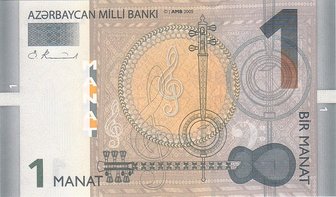The currency name of AZERBAIJAN is the Azerbaijanian Manat

In 1992 Azerbaijan claimed its independence from Russia and established its own currency again. The second Manat was used from 1992 until December 2005. At that time inflation was so high that a new currency was issued to replace the current denominations.
The third Manat, which is still in use, is the new currency of the region. While traders within the country will still accept the second Manat currency at the correct exchange rate, it is now the official money of the region.
Azerbaijan is an industrial region producing many oil products and heavy machinery. While this industry is much in need, it has only been recently that the country has been able to make alliances with countries outside of Russia. In fact, exports to Russia have steadily declined, while exports to Europe and Turkey have risen.
All monetary transactions are regulated by the Central Bank of Azerbaijan, a government controlled entity. The CBA is responsible for the banking and payment systems of the country as well as price stabilization. Recently, the bank has upgraded all of its technology to effectively handle all the requirements of maintaining a viable currency.
The Central Bank of Azerbaijan was formed in 1992, but was officially named the CBA in 2005. The bank has been responsible for keeping the Manat stable during the recent world economic crisis by dropping interest rates from15' to 2', increasing the allowable amount of foreign ownerships in the banks to 50' and dropping reserve requirements down to a historically low .5'. All of these measures have led to financial stability within the country.
While transition from a soviet controlled economy to a free market can still be felt nearly twenty years later, Azerbaijan continues to show a positive growth in their GDP. For several years the growth rate topped over 20', with one year hitting a record breaking 36' - the highest in the world. Since then, the growth rate has stabilized at around 11', keeping the country stable during these trying economic times.
